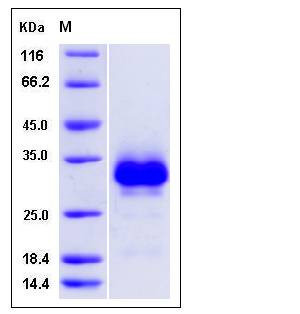Rat TNFRSF11A Protein (His Tag)
TNFRSF11A
- 100ug (NPP3136) Please inquiry
| Catalog Number | P80160-R08H |
|---|---|
| Organism Species | Rat |
| Host | Human Cells |
| Synonyms | TNFRSF11A |
| Molecular Weight | The secreted recombinant rat TNFRSF11A comprises 194 amino acids and predicts a molecular mass of 21.5 kDa. The apparent molecular mass of the rat TNFRSF11A is approximately 32 kDa in SDS-PAGE under reducing conditions. |
| predicted N | Val 31 |
| SDS-PAGE |  |
| Purity | > 97 % as determined by SDS-PAGE |
| Protein Construction | A DNA sequence encoding the rat TNFRSF11A (XP_573424.2) extracellular domain (Met 1-Pro 213) was fused with a polyhistidine tag at the C-terminus. |
| Bio-activity | |
| Research Area | Immunology |Signal Transduction |Cytoskeleton / ECM |Extracellular Matrix |Structures |Bone | |
| Formulation | Lyophilized from sterile PBS, pH 7.4 1. Normally 5 % - 8 % trehalose and mannitol are added as protectants before lyophilization. Specific concentrations are included in the hardcopy of COA. |
| Background | TNFRSF11A is a member of the TNF-receptor superfamily. In mouse, it is also known as CD265. TNFRSF11A contains 4 TNFR-Cys repeats and is widely expressed with high levels in skeletal muscle, thymus, liver, colon, small intestine and adrenal gland. It is an essential mediator for osteoclast and lymph node development. TNFRSF11A and its ligand are important regulators of the interaction between T cells and dendritic cells. It can interact with various TRAF family proteins, through which this receptor induces the activation of NF-kappa B and MAPK8/JNK. Defects in TNFRSF11A can cause familial expansile osteolysis (FEO). FEO is a rare autosomal dominant bone disorder characterized by focal areas of increased bone remodeling. Defects in TNFRSF11A also can cause Paget disease of bone type 2 (PDB2). PDB2 is a bone-remodeling disorder with clinical similarities to FEO. Defects in TNFRSF11A are the cause of osteopetrosis autosomal recessive type 7 which characterized by abnormally dense bone, due to defective resorption of immature bone. |
| Reference |
